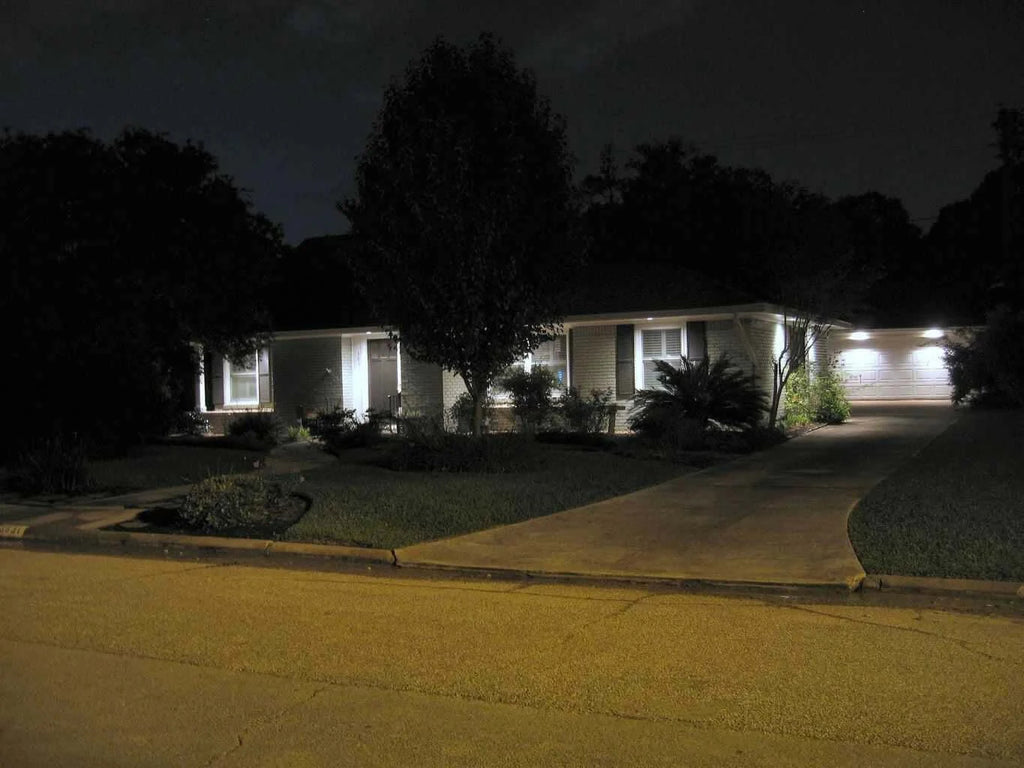Why Choosing Up Lighting Over Recessed Soffit Lighting Improves Your Home's Aesthetics
Exterior soffit lights have become a trendy choice for illuminating the architecture of homes. However, there are various other ways to light up your home beautifully. Shedding light on the architecture of your home can significantly enhance its curb appeal, and who wouldn't want a stunningly illuminated home in the evening? Although soffit lighting has gained popularity, it may not always be the best option from a design perspective. Therefore, in this article, we will explore alternative approaches to beautifully lighting your home.

What makes exterior soffit lights such a favored choice?
Exterior soffit lights have gained popularity due to their ability to provide a functional light source that highlights a home's architecture. This abundance of light can be quite useful, but it doesn't always lead to the best design outcome.
Many examples of well-executed soffit lighting exist, but these do not reflect the less appealing, more common situations. When used without supplemental architectural lighting, soffit lights can create an unattractive effect, making the roofline appear as if it's supporting an enormous glowing object, akin to a giant illuminated jellyfish. This phenomenon, often called the "jellyfish effect," is more widespread than one might think. As you drive through neighborhoods at night, keep an eye out for this peculiar lighting style. While it may not be ideal for everyone, some ocean enthusiasts might find it to be the perfect look.
When it comes to residential lighting projects, it is crucial to use soffit lighting sparingly and appropriately. The jellyfish effect is a common concern, and it is the reason why down lighting from the soffit is not often used in lighting designs. However, if soffit lighting is already present in a home, there are ways to enhance its effect and make it more visually pleasing. By incorporating other lighting effects and working cohesively, soffit lighting can add to the overall ambiance and curb appeal of a home.
What are some ways to enhance exterior soffit lighting?
To enhance the effectiveness of existing soffit lighting, there are a few ways to improve its performance. Initially, it is essential to identify the reasons for any undesirable effects. In our experience, two problems commonly arise with soffit lighting: light intensity (lumen output) and LED color temperature (Kelvin temperature). These issues can create an unbalanced and harsh lighting effect, making it crucial to adjust the intensity and color temperature to create a more visually pleasing and cohesive look. By optimizing these factors, we can achieve a more elegant and subtle lighting design that enhances the architectural features of a home.
Consider the Psychology of Up Lighting and get noticed!

When it comes to lighting up a home, it is important to consider the psychology of up lighting. Natural light originates from above, making lighting from the ground up look unnatural and more noticeable to the human eye. Up lighting from ground-mounted fixtures enhances the exterior of a home and makes it more visually striking than soffit-mounted down lights. This technique draws the eye upwards, highlighting the scale of the home. In contrast, soffit lighting is recessed and tends to pool light on the ground, making the eye focus downwards. Additionally, soffit down lights can leave the soffit and fascia of the home dark, except for the harsh and intrusive light from the soffit light itself. Therefore, incorporating up lighting from ground-mounted fixtures can create a more aesthetically pleasing and effective lighting design for a home.
Minimize glaring lights!
The intensity of the light source, also known as lumen output, can cause glaring lights that lead to the jellyfish effect on homes with soffit lighting. Most homes with soffit lights have a light output that is too bright, resulting in hot spots on the architecture beneath the lights. These glaring lights create a harsh contrast between the dark soffit and bright spots on the architecture, reinforcing the jellyfish effect.
To reduce glare and enhance the ambiance of exterior soffit lighting, adding a dimmer control can make a significant difference. Dimming the lights to less than half their original brightness can create a soft glow that complements the architecture, rather than distracting from it. However, it is important to ensure that the dimming mechanism is appropriate for the type of lights being used, whether LED, halogen, or incandescent.
By adjusting the brightness of soffit lighting and transforming it into a soft glow, a completely different look can be achieved. This technique creates a gentle stroke that complements the architectural features of a home, enhancing its curb appeal and overall visual appeal.
Choose the Right Color Temperature!
Selecting the correct kelvin temperature is essential for achieving the desired effect in soffit lighting. Kelvin temperature refers to the warmth or coolness of a light source, and it is crucial to use the appropriate temperature for the architectural style of the home.
A mismatched color temperature can distract from the overall effect of soffit lighting and worsen the jellyfish effect. For instance, a cooler color temperature, like 5000K, may look stunning on a contemporary home but can seem out of place on a traditional red brick Tudor style home. Using an inappropriate color temperature can make the lights look unnatural and add to the jellyfish effect.
Mixing drastically different color temperatures can also lead to a lackluster result in soffit lighting. It is crucial to use the correct kelvin temperature for the architectural genre to achieve the desired effect. When in doubt, it is always better to consult a professional lighting designer to avoid any mismatches and ensure the correct kelvin temperature is used.
Using the correct kelvin temperature in soffit lighting can create a visually appealing and harmonious look for any home, enhancing its overall curb appeal and aesthetic value.
There are several issues that can arise from improper selection and installation of soffit lighting. Firstly, the lights can be too bright, resulting in a glare that needs to be minimized by dimming the lights. Secondly, the kelvin temperature must be selected carefully to avoid color mismatches, as an inappropriate temperature can make the home look blue or unnatural. Finally, when the entryway lighting and soffit lighting are not in color synchronicity, they can clash and create an unappealing effect. The entryway is a critical architectural element and must be considered when designing a lighting scheme. Ensuring that all architectural pieces work cohesively with one another is essential for creating a visually pleasing and harmonious look for a home's exterior.

Illuminate Your Home With Uplighting!
Architectural up lighting is a lighting technique that involves placing low voltage landscape lights at the foundation of a home to chase light up the different architectural features and trace out the soffit and dormers. By bathing the facade of the home with a soft wash of light, this technique can make a significant difference in enhancing the curb appeal of a home.

The goal of architectural up lighting is to achieve balance and composition by creating a continuous luminous plane. Soft washes of light across the front of a home gently carry the eye from one architectural object to the next, resulting in a visually appealing and harmonious effect. By lighting the home from the foundation up, a gentle wash of light can be thrown across the home, achieving the desired effect of a continuous luminous plane.
When it comes to selecting kelvin temperatures for exterior lighting, it's essential to consider the unique characteristics of each home. Even though many contemporary homes call for cooler lighting temperatures, each design should still be taken into account and given careful consideration. For example, the industrial/earthy look of the rusted steel siding in the above photo required a kelvin temperature that would enhance the warm orange and burgundy tones of the rust, making a cool light temperature inappropriate.
Creating a bespoke lighting design with exterior soffit lighting can be challenging because the placement of lights and fixtures is dependent on the home's soffit and dormers. Limiting architectural lighting to exterior soffit lighting alone may not be sufficient, as it may leave certain areas of the home in the dark. Instead, lighting from the ground up offers greater flexibility and control over the overall lighting effects, resulting in a more sophisticated and visually appealing design with better overall curb appeal.
LeonLites Transforms Your Outdoor Spaces.
In conclusion, landscape lighting is a key factor in enhancing the beauty and curb appeal of any home. Whether it's up lighting, path lighting, deck lighting, or any other type of landscape lighting, each plays an important role in creating a welcoming atmosphere and highlighting the unique features of your home's architecture. At LeonLites, we offer a range of uplights, including well lights, spotlights, and many other landscape lighting options to help you achieve your desired lighting effect. If you have any questions or need guidance on selecting the right lighting for your home, don't hesitate to contact us a call. Our team of experts is always available to provide you with the best advice and solutions for your landscape lighting needs. Let us help you make all the difference in the beauty and appeal of your home with our exceptional landscape lighting products.












